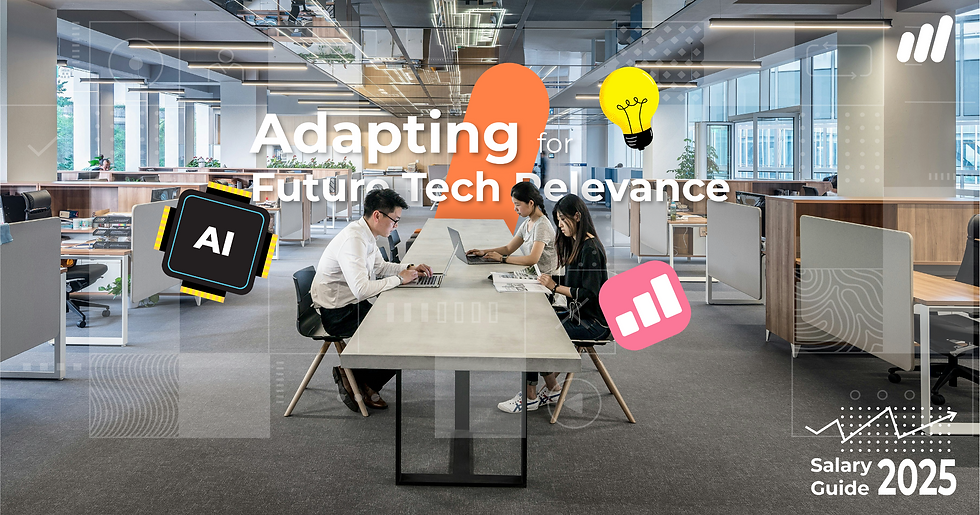As we move further into the 2020s, the recruitment landscape is rapidly evolving to meet the challenges of a fast-paced digital world. The demand for IT talent is soaring, especially in emerging fields such as artificial intelligence, blockchain technology, and data science. This surge is not just a fleeting trend, it reflects a fundamental shift in how businesses operate and compete. Companies are now tasked with refining their recruitment strategies to attract and retain the right talent in an increasingly competitive market. In this article, we will explore the key recruitment trends and the future of work in Vietnam IT industry in 2025, emphasizing the factors driving the demand for IT talent and the innovative strategies companies employ to meet this demand.
1. The rise of AI, Blockchain, and Data Science
The rapid advancement of technology has fundamentally transformed industries and reshaped the workforce. As digitalization permeates every sector, the need for skilled IT professionals has skyrocketed, reshaping the future of work in Vietnam IT industry. According to the Vietnam IT Salary Guide 2025 by JT1, approximately 97 million new roles could emerge that are more adapted to the new division of labor between humans, machines, and algorithms. This emphasizes the growing importance of IT skills and reinforces the urgent need for companies to prioritize recruitment in these fields.

Among the various segments of IT, three fields stand out for their explosive growth:
Artificial intelligence: Professionals with expertise in machine learning, natural language processing, and robotics are becoming more and more in demand as AI continues to improve corporate processes through automation and data analysis. Businesses are looking for bright people who can create AI-powered solutions that enhance customer satisfaction and operational effectiveness. With collaborations with international tech behemoths like NVIDIA, Google, and AWS propelling advances in generative AI, Vietnam's National AI Strategy (2021) seeks to establish the nation as a major force in AI innovation by 2030.
Blockchain technology: Blockchain has become a game-changing technology in several sectors with the emergence of cryptocurrencies and decentralized finance. Businesses are searching for business analysts and blockchain developers who can use blockchain solutions in industries including banking, healthcare, and supply chain management. The number of blockchain businesses in Vietnam is also rising, which is increasing the need for qualified experts in this area.
Data science: The need for data scientists who can sort through enormous volumes of data to extract useful insights has increased due to the emergence of big data. The need for expertise in statistics, data visualization, and data mining is increasing as a result of businesses depending on data scientists to assist and guide their initiatives. By 2024, Vietnam's digital economy is predicted to have grown by 20% a year to reach $36 billion, which would increase the need for data science specialists.
2. The challenges of the current recruitment landscape
In light of this overwhelming demand, organizations face several challenges when trying to secure top IT talent. One of the most significant issues is the fierce competition as companies vie for a limited pool of skilled professionals. The “Great Resignation” has also impacted the labor market dynamics, with many IT workers reevaluating their career choices and seeking better opportunities that offer job satisfaction, flexibility, and competitive compensation.
2.1. Navigating the Talent Shortage
To address the prevalent talent shortage, companies must adopt innovative recruitment strategies. Traditional methods no longer suffice; employers must be proactive and adapt to the shifting landscape. Here are a few key strategies companies are employing:
Building a strong employer brand: To attract top talent, organizations must cultivate a compelling employer brand that resonates with potential candidates. This involves transparent communication about company values, culture, and growth opportunities. Leveraging social media and platforms like LinkedIn can help amplify this brand narrative to attract skilled professionals.
Focusing on diversity and inclusion: Companies are increasingly recognizing the importance of diversity in fostering innovation and enhancing team performance. By prioritizing diversity and inclusion in their hiring processes, organizations can tap into a broader talent pool and benefit from varied perspectives and experiences.
Offering flexible work arrangements: The COVID-19 pandemic has permanently shifted employee expectations, with many individuals prioritizing flexibility in their work arrangements. Companies that offer remote work options, flexible hours, and hybrid models are more likely to attract and retain top talent in IT fields.
2.2. Upskilling and Reskilling Initiatives
Another integral aspect of addressing the talent shortage is investing in the development of existing employees. Upskilling and reskilling initiatives allow companies to bridge the skill gap and cultivate a workforce better suited to meet emerging technological demands.
Training programs: Organizations can create tailored training programs that enhance employees' IT skills in areas such as AI, data analytics, or cloud computing. By providing access to online courses and workshops, companies can equip their workforce with the necessary competencies to thrive in the future of work in Vietnam IT industry.

Businesses can open relevant training programs for their employees to make them more capable of the latest trends in the IT industry Partnerships with educational institutions: Companies may assist recruit new talent and support the development of future IT workers by working with colleges and hosting coding boot camps. Co-ops and internships provide students with invaluable practical experience that enables them to use their talents in authentic situations. With more than 80,000 IT graduates each year, Vietnam's government is also making investments in IT education, guaranteeing a consistent supply of qualified workers.
2.3. Adoption of advanced recruitment technologies
As the recruitment landscape becomes more data-driven, employers increasingly turn to advanced recruitment technologies to streamline their hiring processes. Artificial intelligence and machine learning are being leveraged to optimize candidate sourcing, screening, and selection.
AI-powered hiring tools: AI-driven recruitment software can analyze job applications, assess qualifications, and identify the best-fit candidates more efficiently. By eliminating biases in the screening process, these tools help organizations find talent that aligns with their needs.
Predictive analytics: Predictive analytics allows companies to forecast talent needs, helping them plan their recruitment strategies based on evolving industry trends. By analyzing data trends and historical applications, organizations can make informed decisions to bolster their talent acquisition efforts.
3. The Role of Government and Policy in Shaping the Vietnam IT Industry
Government funding and policies have a big impact on the Vietnam IT industry in addition to private sector activities. The Vietnamese government has put measures in place to support the growth of the IT industry because it understands how crucial it is to the country's economic expansion.
Initiatives for Digital Transformation: To encourage the adoption of digital technology in a variety of industries, the Vietnamese government has started a number of initiatives for digital transformation. The National Digital Transformation Program is one of these programs, with the goal of transforming Vietnam into a digital society by 2030. It is anticipated that this initiative will foster an atmosphere that will support the expansion of the IT sector and raise the need for IT specialists.
Investment in Education and Training: The government has been funding educational initiatives to provide workers with the IT skills they need in order to alleviate the talent gap. This involves forming alliances with foreign firms and setting up IT training facilities all around the nation. These initiatives are essential to guaranteeing a consistent flow of qualified IT specialists to satisfy the rising demand.
International Investment Incentives: To entice international investment in the IT industry, the Vietnamese government has also been providing incentives. Tax rebates, lower land leasing costs, and expedited administrative processes are some examples of these incentives. The government hopes to increase employment possibilities and promote knowledge transfer by drawing in international businesses, which would help the Vietnam IT sector even more.
Conclusion
As we look towards 2025, the transformation of the recruitment landscape is clear. The surging demand for IT talent, particularly in areas like AI, blockchain, and data science, is reshaping how organizations attract and retain skilled professionals. Companies that embrace innovative recruitment strategies including building strong employer brands, focusing on diversity and inclusion, offering flexible work options, investing in upskilling initiatives to prepare for the future of work in Vietnam IT industry, and adopting advanced recruitment technologies will be better positioned to navigate the competitive talent market.
Are you ready to navigate the dynamic IT landscape in Vietnam? The Vietnam IT Salary Guide 2025 is your ultimate resource for understanding salary trends, emerging roles, and skills in the highest demand. Packed with insights into Vietnam’s evolving position as a regional tech hub, this report empowers businesses and professionals to make informed decisions in a competitive market.
Don’t miss the chance to gain a strategic edge in recruitment, workforce planning, and salary benchmarking. Download the full report now!



Comments